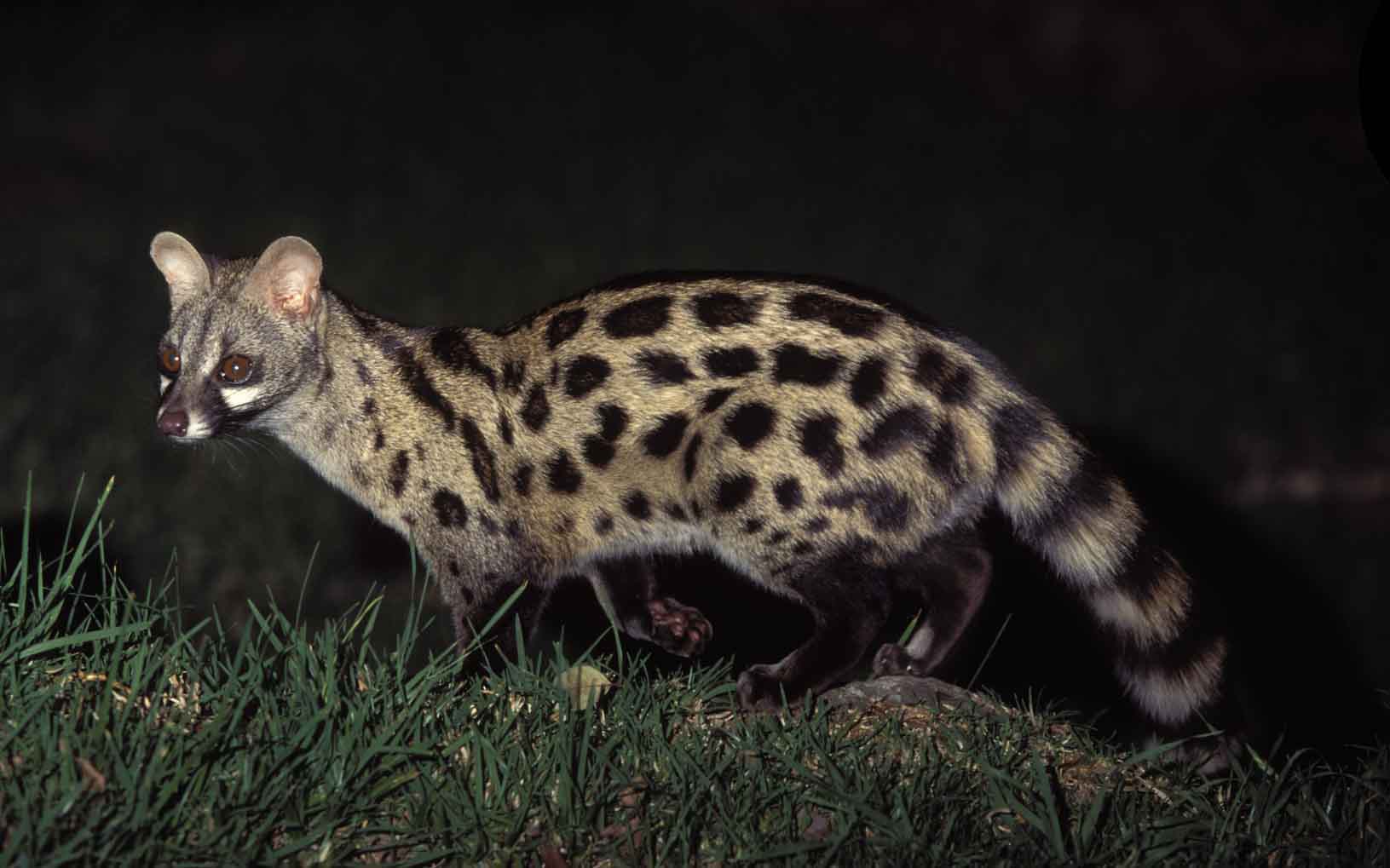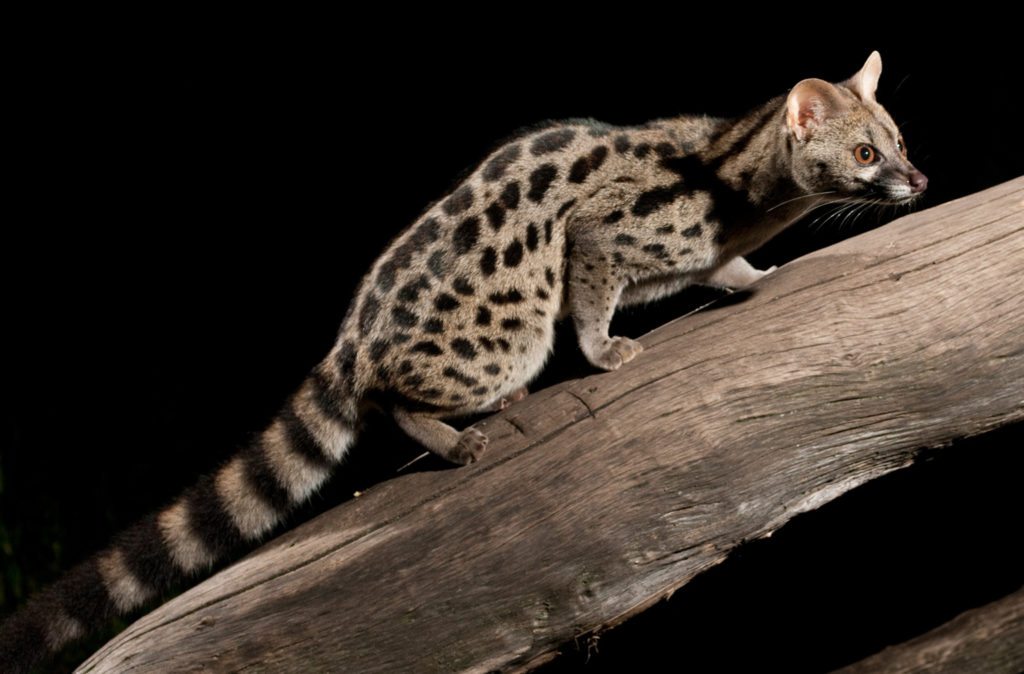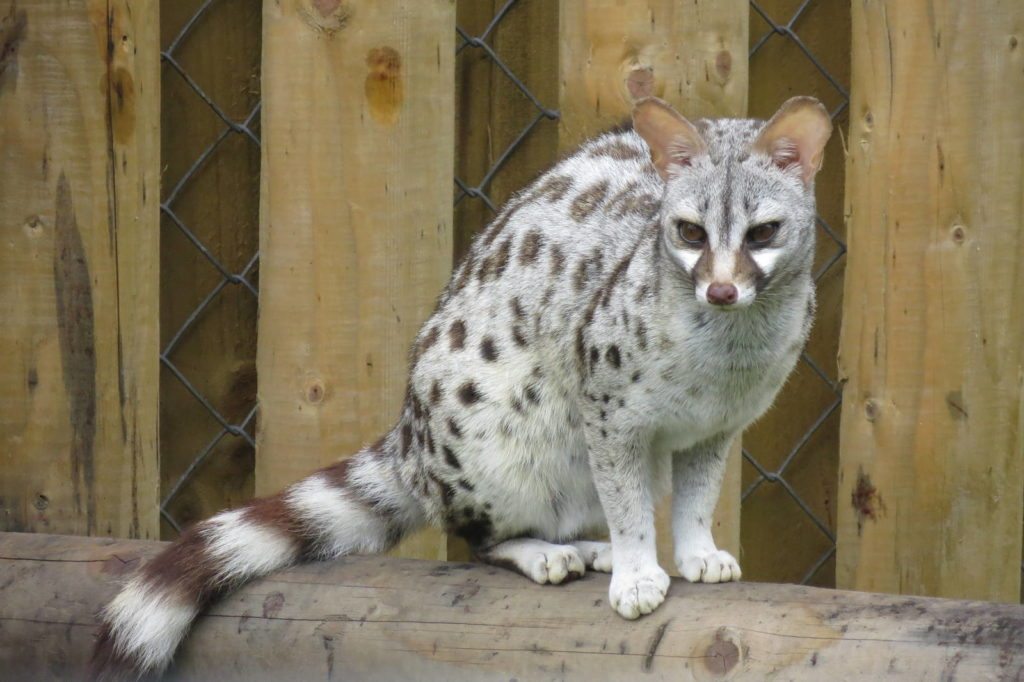As I crouched in front of a tree trunk on the edge of a Spanish woodland, miles from the nearest urban street light, questions whirled around my head. The sun was close to setting, though I wouldn’t have known it from looking at the sky due to the thick, enveloping cloud that stretched to the horizon. It was a surprisingly chilly February evening, given that I was in Extremadura in south-west Spain, and I was beginning to wonder if I was a tad under dressed. My mental musings concerned my quarry at this secret site. Would it appear, and what would it look like?
How would it behave? It was an animal that I barely knew anything about, had never really even thought about and had certainly never seen before: a common genet. In fact until recently I didn’t even know anyone who had seen one in the wild. However, here I was with the award-winning wildlife photographer Jose-Elias Rodriguez Vazquez awaiting the appearance of not one but three apparently very approachable common genets he had discovered and staked out. An assiduous naturalist, Jose-Elias knows every inch of the countryside that surrounds his home near Alange, in the south of the province.

The local habitat includes olive plantations, holm oak woodlands and reservoirs, all bordered in the near distance by a range of mountains. It is a very picturesque landscape; it’s no wonder he says that the common genets love it here. Jose-Elias first became aware of the existence of the genets by chance during the autumn of 2012, when he noticed their scats in a tiny, isolated woodland surrounded by olive plantations near his home. Genets create latrines to mark the borders of their territory. These are normally sited in conspicuous places, such as on rocks. Their scats are curved with a pointed end, and contain a lot of fur and other indigestible parts from the animals’ prey.
Jose-Elias’ genets had deposited their dung on a dead tree stump, and after a while these piles of droppings had become dry and brittle, breaking up into short pieces but still recognisable. Having made the discovery Jose-Elias decided to set up camera-traps where he thought that the animals roamed, and play the patience game. Despite his initial optimism, for the first few nights he recorded nothing. A week later, though, he got what he was after: a shot of an adult common genet. He was ecstatic at the great opportunity to photograph an animal that he had only glimpsed twice in his life.
Though the species is thought to be distributed throughout southern Spain, most of the local people are completely unaware that they are sharing their country with such an exotic creature. In fact no one even knows how many genets there are in Europe – the Spanish Society for the Conservation and Study of Mammals says that no study has been commissioned on them, nor are there any guesstimates of the Spanish population.
AVERY UNUSUAL FAMILY – Genets, along with civets, belong to a diverse family distributed throughout Africa and Asia. Most of the species are poorly known because of their nocturnal habits. The current range of the common genet includes parts of Southern Africa (from Namibia to Mozambique in the east), a band of sub-Saharan Africa (from Senegal east to the Horn of Africa), the Arabian Peninsula and North Africa. Common genets are also found throughout the Iberian Peninsula, north into southern and western France.
They favour Mediterranean oak and pine woodlands, scrubland and rocky areas, typically with a source of water nearby. Genets spotted elsewhere in Europe are believed to have escaped from captivity. There are two schools of thought as to how common genets spread into Europe. Some think that the animals in the Iberian Peninsula are a remnant population isolated after the Gibraltar land bridge was breached by the Mediterranean Sea more than three million years ago. A size variation, with smaller specimens in the north of the range, suggests that the European distribution of the genet has been natural.

The second theory is that they were brought as pets to Iberia by the Moors. They are affectionate and easily house-trained, and are thought to have been kept as rat-catchers until the modern domestic cat superseded them in the Middle Ages. What is known for sure is that the populations on the Balearic Islands were most certainly introduced by humans. The genets found on Ibiza, for example, are smaller than their counterparts in mainland Spain and seem to resemble a form of the feline genet, a closely related species in Africa.
CAMERA-TRAP DISCOVERY – Whatever the origins of his genets, Jose-Elias took full advantage of their acceptance of his camera-traps. Theorising that they must have gotten used to his scent, he decided to take a risk and try photographing them in person. His hunch paid off, because only minutes after he had settled into position, out in the open and without a hide, a genet appeared and foraged around him with little concern. Over three months of daily visits Jose-Elias built up the animal’s trust, and his patience was rewarded one evening when two individuals arrived to root about at close range.
He even received an unexpected and very welcoming gift: on Christmas Day that year, when a third individual joined the duo. As Jose-Elias had discovered, common genets are interesting creatures. They resemble the love child of a cat crossed with a smidgen of mongoose and a touch of marten, with a soupcon of lemur thrown in for good measure. About the size of a short-legged tabby, they are essentially grey-brown with a distinctive blend of black stripes and spots: their flanks and legs are spotted while a black stripe runs from their shoulders along their spines to the base of their long, bushy, ringed tail.
They have a relatively small head and a pointed muzzle with small, erect ears. The face is well marked with the strong black-and-white designs around the muzzle that are so typical of many nocturnal predators. Most species of genet share the retractable claws and the feline look of cats, and indeed common genets have been observed adopting the same defensive posture when they feel threatened, arching their backs with their dorsal and tail hairs erect while hissing through bared teeth.
STEALTHY HUNTERS – Keen eyesight and a lithe build make genets proficient hunters. They are generally unobtrusive animals, hence their low profile in Spain and elsewhere, feeding mostly on small mammals and occasionally small birds, reptiles, amphibians and fish, as well as invertebrates. They are excellent users of stealth, stalking their prey in a series of speedy dashes punctuated by short pauses. They are often described as quiet animals, but they do vocalise occasionally and their kits can purr.
Females sometimes utter a hiccupping sound to their young and, in a nod to their feline roots, copulating adults meow and the female will utter a growl when she ushers the male away. In Europe common genets can breed all year but tend to produce two to four young between April and September. The kits are born in a vegetation-lined nest in a tree or burrow. They are blind at birth but their eyes are open by the time they start to venture from the nest eight days later.

They are weaned after six months, becoming independent after a year and sexually mature after two. Genets are proficient climbers too, but happily for an eager photographer seem to spend a lot of their time on the ground. They are also rather solitary, with one study finding that males command territories of up to 113ha and females up to 72ha. Of the two sexes, the female appears to be the more territorial.
ANCIENT LINEAGE – The genet and civet family, Viverridae, appears to represent an ancient family of feliform lineage that branched off. Throughout the world there are generally considered to be 34 species in the family, though further taxonomic research may alter this number. A number of them are sadly of conservation concern, largely due to the threat of habitat destruction. Currently the clan includes six species of large terrestrial civets, 17 species of the slender and semi-arboreal genets and oyans, about four species of banded palm civets and the strange aquatic otter civets.
Finally there are at least seven very arboreal species that include another group of palm civets and the curious black and hairy binturong from Asia, which is also known as the bearcat. The oddest member of the tribe is the fosa from Madagascar. It is a very cat-like animal that is highly arboreal and preys on lemurs as its food of choice. One of the unusual things about the fosa is that it is the only known mammal where young females temporarily develop masculine characteristics before returning to be fully feminine in adulthood. The Viverridae family also once included mongooses, with which they share several traits.
However, recent molecular studies have concluded that the mongoose is more closely related to hyenas. Back at my stakeout it was nearly dark, and I was beginning to dream of a tapas dinner washed down with a good Spanish wine when I heard a rustle. Three genets appeared in front of me, foraging in the low branches and on the ground. Jose-Elias later told me that it was a female with two well-grown kits. They paid no heed to either of us; one even approached to within 20cm of where we sat.
Whether they were descendants of medieval pets or bona fide natives from millennia ago didn’t matter to me – I was in heaven either way. I may never see another wild genet in my life, but at least I now have a connection with a special creature whose secret life I glimpsed one cold winters night in Spain.















